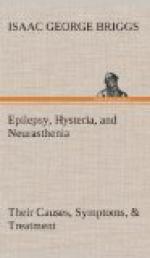The whole body then becomes stiff. The hands are clenched, with thumbs inside the palms, the legs are extended, the arms stiffly bent, and the head thrown back, or twisted to one side. The muscles of the chest and heart are impeded in their action, breathing ceases, the heart is slowed, and the face becomes pale, and then a livid, dusky blue.
The skin is cold and clammy, the eyebrows knit; the tongue may be protruded, and bitten between the teeth. The eyeballs seem starting from their sockets, the eyes are fixed or turned up, so that only the sclerotic ("whites”) can be seen, and they may be touched or pressed without causing blinking. The stomach, bladder, and bowels may involuntarily be emptied.
This tonic stage only lasts a few seconds, and is followed by convulsions. The head turns from side to side, the jaws snap, the eyes roll, saliva and blood mingle as foam on the lips, the face is contorted in frightful grimaces, the arms and legs are twisted and jerked about, the breathing is deep and irregular, the whole body writhes violently, and is bathed in sweat.
The spasms become gradually less severe, and finally cease. Deep breathing continues for some seconds; then the victim becomes semi-conscious, looks around bewildered, and sinks into coma or deep sleep.
“...As one that falls, He knows not how, by force demoniac dragg’d To earth, and through obstruction fettering up In chains invisible the powers of Man; Who, risen from his trance, gazeth around Bewilder’d with the monstrous agony He hath indured, and, wildly staring, sighs: ...”
In a few hours he wakes, with headache and mental confusion, not knowing he has been ill until told, and having no recollection of events just preceding the seizure, until reminded of them when they are slowly, and with painful effort, brought to mind. He is exhausted, and often vomits. In severe cases he may be deaf, dumb, blind, or paralysed for some hours, while purple spots (the result of internal hemorrhage) may appear on the head and neck. Victims often pass large quantities of colourless urine after an attack, and, as a rule, are quite well again within twenty-four hours.
This is the usual type, but seizures vary in different patients, and in the same sufferer at different times. The cry and the biting of the tongue may be absent, the first spasm brief, and the convulsions mild. Epilepsy of all kinds is characterized by an alteration (not necessarily a loss) of consciousness, followed by loss of memory for events that occurred during the time that alteration of consciousness lasted.
Attacks may occur by day only, by day and by night, or by night only, though in so-called nocturnal epilepsy, it is sleep and not night that induces the fit, for night-workers have fits when they go to sleep during the day.
Victims of nocturnal epilepsy may not be awakened by the seizure, but pass into deeper sleep. Intermittent wetting of the bed, occasional temporary mental stupor in the morning, irritability, temporary but well-marked lapses of memory, sleep-walking, and causeless outbursts of ungovernable temper all suggest nocturnal epilepsy.




